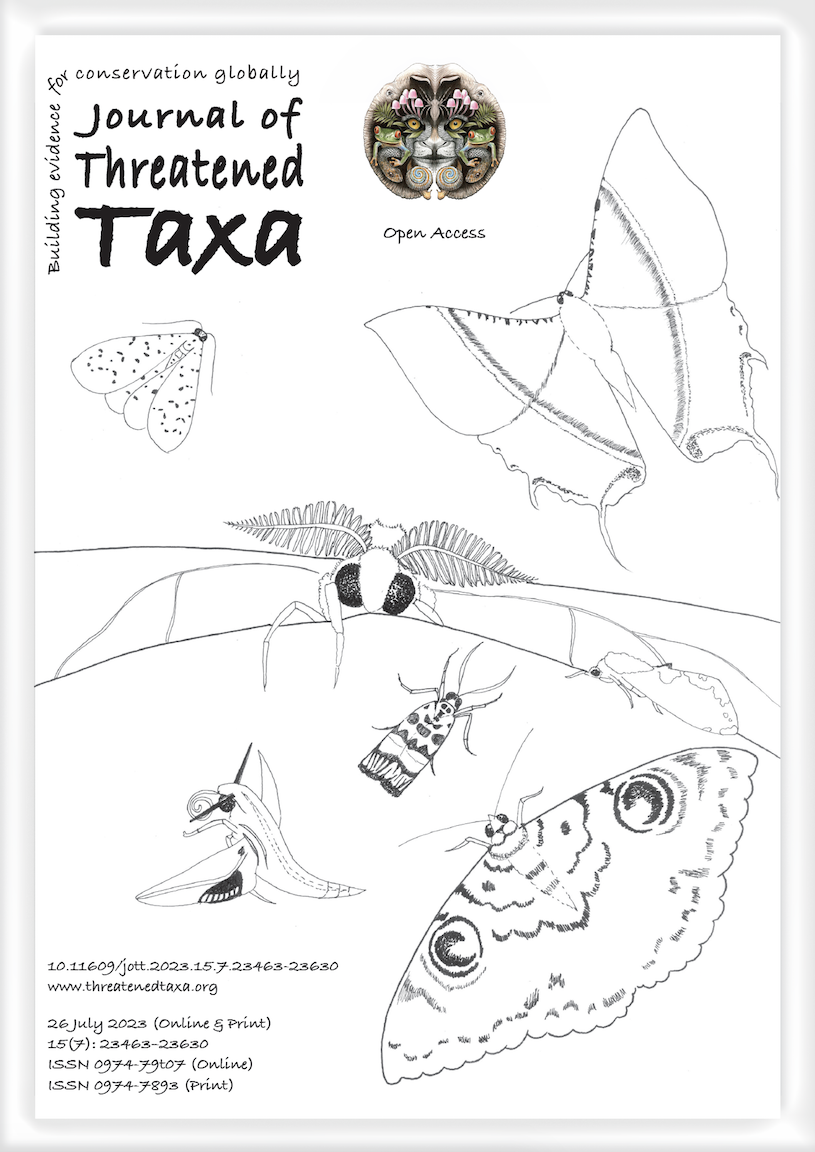Developing a fast, reproducible, and simple protocol for virtual lichen herbarium using barcoding and QR code techniques
Main Article Content
Abstract
In recent days, biological specimens are digitalized and digital images are available in virtual herbarium for teaching and learning process. Now, there is a need to explore possibilities of usage of barcodes and quick response (QR) codes in developing virtual herbarium for quick access as well as study the taxonomy of repository specimens. In order to establish a virtual herbarium for lichens using barcode and QR code techniques, lichen specimens such as Chrysothrix candelaris (L.) J.R.Laundon, Leucodermia leucomelos (L.) Kalb, Heterodernia flabellate (fee) D.D.Awasthi, Parmotrema andinum (Mull.Arg.) Hale, Parmotrema grayanum (Hue) Hale, Parmellinella stuppeum (Taylor) Hale, and Ramalina intermedia (Delise ex Nyl.) Nyl. were collected from the Eastern Ghats and the Western Ghats of Tamil Nadu, India and were identified based on morphological, anatomical and biochemical methods. Moreover, these specimens were preserved in the conventional lichen herbarium as reference materials for future studies. The barcodes and QR codes were generated for all the repository specimens to access the materials as well as to get a complete description of the lichen specimens. The generated barcodes provided the binomial name of lichen specimens along with their accession number. Similarly, the QR codes provided the digital image of lichen specimens along with complete descriptions such as distribution, habit and habitat, growth forms, name of the family, reproductive structure, chemistry, nature of thallus structure and lichen secondary metabolites. From these studies, we standardized a simple, rapid with reproducible protocol to develop a virtual herbarium for lichens to get the digital image and to access the complete descriptions of lichen specimens. This study might be useful for Lichenologists to get information about lichens in digital form and to maintain the lichen wealth for future regenerations without disturbing the lichen biodiversity.
Article Details

This work is licensed under a Creative Commons Attribution 4.0 International License.
Authors own the copyright to the articles published in JoTT. This is indicated explicitly in each publication. The authors grant permission to the publisher Wildlife Information Liaison Development (WILD) Society to publish the article in the Journal of Threatened Taxa. The authors recognize WILD as the original publisher, and to sell hard copies of the Journal and article to any buyer. JoTT is registered under the Creative Commons Attribution 4.0 International License (CC BY), which allows authors to retain copyright ownership. Under this license the authors allow anyone to download, cite, use the data, modify, reprint, copy and distribute provided the authors and source of publication are credited through appropriate citations (e.g., Son et al. (2016). Bats (Mammalia: Chiroptera) of the southeastern Truong Son Mountains, Quang Ngai Province, Vietnam. Journal of Threatened Taxa 8(7): 8953–8969. https://doi.org/10.11609/jott.2785.8.7.8953-8969). Users of the data do not require specific permission from the authors or the publisher.
References
Ahmadjian, V. (1993). The Lichen Symbiosis. John Wiley & Sons, New York, US, 250 pp.
Awasthi, D.D. (2007). A compendium of the Macro lichens from India, Nepal and Sri Lanka, Bishen Singh Mahendrapal Singh, Dehra Dun, India, 580 pp.
Chase, M.W. & M.F. Fay (2009). Barcoding of Plants and Fungi. Science 325: 682–683. https://doi.org/10.1126/science.1176906
Chen, N.S., D.C.E. Teng, C.H. Lee & Kinshuk (2011). Augmenting paper-based reading activity with direct access to digital materials and scaffolded questioning. Computers & Education 57(2): 1705–1715. https://doi.org/10.1016/J.COMPEDU.2011.03.013
Diazgranados, M. & V.A. Funk (2013). Utility of QR codes in biological collections. PhytoKeys 25: 21–34. https://doi.org/10.3897/phytokeys.25.5175
Dmitry E.K., V.A. Bakalin, E.A. Pimenova, V.P. Verkholat & P.V. Krestov (2017). An electronic management system for a digital herbarium: Development and future prospects. Botanica Pacifica 6(2): 59–68. https://doi.org/10.17581/bp.2017.06207
Flannery, M.C. (2013). Plant collections online: Using digital herbaria in biology teaching. Bioscene 39: 1–9.
Lai, M.Y. (2006). Classification of Lichen Species Using Artificial Neural Networks. Fakulti Sains Komputer dan Teknologi Maklumat, Universiti Malaya, 200 pp.
Law, C. & S. So (2010). QR Codes in Education. Journal of Educational Technology Development and Exchange 3: 85–100. https://doi.org/10.18785/jetde.0301.07
Nayaka, S. & D.K. Upreti (2013). Lichens of Uttar Pradesh. Uttar Pradesh State Biodiversity Board, Lucknow, UP, India, 187 pp.
Orange, A., P.W. James & F.J. White (2001). Microchemical methods for the identification of lichens. British Lichen Society, UK, 101 pp.
Patmore, K. (2010). All Vascular Types On-line. Global Plants Initiative. https://gpi.myspecies.info/content/all-vascular-typesline-global-plants-initiative
Primack, D., C. Imbres, R.B. Primack, A.J. Miller-Rushing & P. Del Tredici (2004). Herbarium specimens demonstrate earlier flowering times in response to warming in Boston. American Journal of Botany 91(8): 1260–1264. https://doi.org/10.3732/ajb.91.8.1260
Rao, S., A.N. Sringeswara, D. Kumar, S. Pulla & R. Sukumar (2012). A digital herbarium for the flora of Karnataka. Current Science 102: 1268–1271.
Reveal, J.L. (2008). Lewis and Clark Herbarium-Plants collected by Lewis and Clark. http://www.plantsystematics.org/reveal/pbio/LnC/LnCherbindex.html.
Singh, R. & K. Sharma (2009). Indian Virtual Herbarium Project: Implementing an institutional knowledge repository as a digital archive – Design, development, solution architecture and implementation. Journal of Digital Asset Management 5(2): 55–74. https://doi.org/10.1057/dam.2008.56
Singh, A. & P. Singh (2016). Evaluating quick response code and its scanning process using USB device. International Journal of New Innovations in Engineering and Technology 5(4). 45–54.
Sreekumar, V.B., K.H. Hussain & C. Renuka (2017). Virtual herbarium of Kerala Forest Research Institute, Peechi, Kerala, India. Current Science 112(3): 466–470. https://doi.org/10.18520/cs/v112/i03/466-470
Upreti, D.K., S. Nayaka & A. Bajpai (2005). Do lichens still grow in Kolkata City? Current Science 88(3): 338–339.

